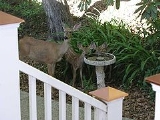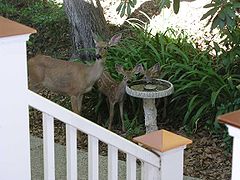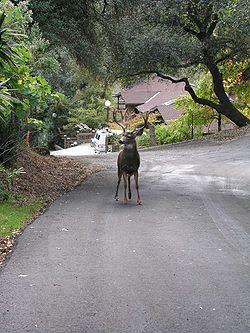
California Mule Deer
Encyclopedia
California mule deer, Odocoileus hemionus californicus, is a subspecies of mule deer
whose range covers much of the state of California
. This species
is widespread throughout northern and central California in the California coastal prairie
as well as inner coastal ranges and interior mountains, especially the Sierra Nevada. This deer will much less frequently be found on the floor of the interior valley
s, and then it will mostly frequent riparian zone
s. Generally this species has a preference for hill terrain, especially an oak
woodland
habitat
. The California mule deer is a browser and will typically take over ninety percent of its diet from shrubs and leaves and the balance from grasses. One of the principal means of distinguishing the closely related black-tailed deer
and white-tailed deer
is the growth habit of the buck's antler
s. In the case of the California mule deer, the antlers fork in an upward growth, whereas the other species' antlers grow in a forward direction.
of California are known to have hunted California mule deer. Thus, since about 12,000 BC, Gage suggests that human population
s have served as a control to the numbers of California mule deer. In the modern era, since Europe
ans settled in California, hunting pressure intensified as the human population expanded
and hunting became an activity not only associated with food supply. In addition human population growth (through urban development) in California has consumed large amounts of natural habitat of the California mule deer starting in the early 19th century and continuing through the present.
Repeated beds will often be scratched to a nearly level surface, about two meters in diameter. Less regularly used bedding areas are manifested as flattened grass. On hot summer days California mule deer often seek shade and rest in the mid-day.
In summer, California mule deer mainly browse on leaves of small trees, shrubs and herbaceous plants, but also consume many types of berry
(including blackberry
, huckleberry
, salal
and thimbleberry
. In winter, they may expand their forage to conifers (particularly twigs of Douglas fir), aspen
, willow
, dogwood
, juniper
, and sage
. Year-round, they will feed on acorn
s; grasses are a secondary food source. Where humans have encroached on historic deer habitat by suburban development or orchards, California mule deer will diversify their diet with garden
plant material, with tree fruit, and, occasionally, even with pet food.
Fawns and does tend to forage together in familial groupings while bucks tend to travel singly or with other bucks. California mule deer browse most actively near dawn and dusk, but will also forage at night in open agricultural areas or when experiencing hunting
pressure.

behavior in competing for mates. Does will begin oestrus again if they do not mate. The gestation
period is approximately 200 days, with fawns arriving in the spring; the young will remain with mothers throughout the summer and become weaned in the autumn. The buck's antlers fall off in the winter-time and commence growing once more in spring in anticipation of next autumn's rut.

Mule Deer
The mule deer is a deer indigenous to western North America. The Mule Deer gets its name from its large mule-like ears. There are believed to be several subspecies, including the black-tailed deer...
whose range covers much of the state of California
California
California is a state located on the West Coast of the United States. It is by far the most populous U.S. state, and the third-largest by land area...
. This species
Species
In biology, a species is one of the basic units of biological classification and a taxonomic rank. A species is often defined as a group of organisms capable of interbreeding and producing fertile offspring. While in many cases this definition is adequate, more precise or differing measures are...
is widespread throughout northern and central California in the California coastal prairie
California coastal prairie
California coastal prairie, also known as northern coastal grassland, is a grassland plant community of California and Oregon in the Temperate grasslands, savannas, and shrublands Biome...
as well as inner coastal ranges and interior mountains, especially the Sierra Nevada. This deer will much less frequently be found on the floor of the interior valley
Valley
In geology, a valley or dale is a depression with predominant extent in one direction. A very deep river valley may be called a canyon or gorge.The terms U-shaped and V-shaped are descriptive terms of geography to characterize the form of valleys...
s, and then it will mostly frequent riparian zone
Riparian zone
A riparian zone or riparian area is the interface between land and a river or stream. Riparian is also the proper nomenclature for one of the fifteen terrestrial biomes of the earth. Plant habitats and communities along the river margins and banks are called riparian vegetation, characterized by...
s. Generally this species has a preference for hill terrain, especially an oak
Oak
An oak is a tree or shrub in the genus Quercus , of which about 600 species exist. "Oak" may also appear in the names of species in related genera, notably Lithocarpus...
woodland
Woodland
Ecologically, a woodland is a low-density forest forming open habitats with plenty of sunlight and limited shade. Woodlands may support an understory of shrubs and herbaceous plants including grasses. Woodland may form a transition to shrubland under drier conditions or during early stages of...
habitat
Habitat
* Habitat , a place where a species lives and grows*Human habitat, a place where humans live, work or play** Space habitat, a space station intended as a permanent settlement...
. The California mule deer is a browser and will typically take over ninety percent of its diet from shrubs and leaves and the balance from grasses. One of the principal means of distinguishing the closely related black-tailed deer
Black-tailed Deer
Two forms of black-tailed deer or blacktail deer occupying coastal temperate rainforest on North America's Pacific coast are subspecies of the mule deer. They have sometimes been treated as a species, but virtually all recent authorities maintain they are subspecies...
and white-tailed deer
White-tailed Deer
The white-tailed deer , also known as the Virginia deer or simply as the whitetail, is a medium-sized deer native to the United States , Canada, Mexico, Central America, and South America as far south as Peru...
is the growth habit of the buck's antler
Antler
Antlers are the usually large, branching bony appendages on the heads of most deer species.-Etymology:Antler originally meant the lowest tine, the "brow tine"...
s. In the case of the California mule deer, the antlers fork in an upward growth, whereas the other species' antlers grow in a forward direction.
History of the species
Since prehistoric times Native AmericansNative Americans in the United States
Native Americans in the United States are the indigenous peoples in North America within the boundaries of the present-day continental United States, parts of Alaska, and the island state of Hawaii. They are composed of numerous, distinct tribes, states, and ethnic groups, many of which survive as...
of California are known to have hunted California mule deer. Thus, since about 12,000 BC, Gage suggests that human population
Population
A population is all the organisms that both belong to the same group or species and live in the same geographical area. The area that is used to define a sexual population is such that inter-breeding is possible between any pair within the area and more probable than cross-breeding with individuals...
s have served as a control to the numbers of California mule deer. In the modern era, since Europe
Europe
Europe is, by convention, one of the world's seven continents. Comprising the westernmost peninsula of Eurasia, Europe is generally 'divided' from Asia to its east by the watershed divides of the Ural and Caucasus Mountains, the Ural River, the Caspian and Black Seas, and the waterways connecting...
ans settled in California, hunting pressure intensified as the human population expanded
Overpopulation
Overpopulation is a condition where an organism's numbers exceed the carrying capacity of its habitat. The term often refers to the relationship between the human population and its environment, the Earth...
and hunting became an activity not only associated with food supply. In addition human population growth (through urban development) in California has consumed large amounts of natural habitat of the California mule deer starting in the early 19th century and continuing through the present.
Browsing behavior
California mule deer usually browse close to lakes or streams providing their water source. From that reference point of water consumption they may roam one to two miles, and typically make their beds in grassy areas beneath trees within such a one mile distance radius from both water and forage.Repeated beds will often be scratched to a nearly level surface, about two meters in diameter. Less regularly used bedding areas are manifested as flattened grass. On hot summer days California mule deer often seek shade and rest in the mid-day.
In summer, California mule deer mainly browse on leaves of small trees, shrubs and herbaceous plants, but also consume many types of berry
Berry
The botanical definition of a berry is a fleshy fruit produced from a single ovary. Grapes are an example. The berry is the most common type of fleshy fruit in which the entire ovary wall ripens into an edible pericarp. They may have one or more carpels with a thin covering and fleshy interiors....
(including blackberry
Blackberry
The blackberry is an edible fruit produced by any of several species in the Rubus genus of the Rosaceae family. The fruit is not a true berry; botanically it is termed an aggregate fruit, composed of small drupelets. The plants typically have biennial canes and perennial roots. Blackberries and...
, huckleberry
Huckleberry
Huckleberry is a common name used in North America for several species of plants in two closely related genera in the family Ericaceae:* Vaccinium* GaylussaciaHuckleberry may also refer to:-Plants:...
, salal
Salal
Gaultheria shallon is a leathery-leaved shrub in the heather family , native to western North America. In English it is known as salal, shallon, or in Britain simply Gaultheria.-Ecology:...
and thimbleberry
Thimbleberry
Rubus parviflorus, commonly called thimbleberry or salmonberry, is a species of Rubus, native to western and northern North America, from Alaska east to Ontario and Michigan, and south to northern Mexico...
. In winter, they may expand their forage to conifers (particularly twigs of Douglas fir), aspen
Aspen
Populus section Populus, of the Populus genus, includes the aspen trees and the white poplar Populus alba. The five typical aspens are all native to cold regions with cool summers, in the north of the Northern Hemisphere, extending south at high altitudes in the mountains. The White Poplar, by...
, willow
Willow
Willows, sallows, and osiers form the genus Salix, around 400 species of deciduous trees and shrubs, found primarily on moist soils in cold and temperate regions of the Northern Hemisphere...
, dogwood
Dogwood
The genus Cornus is a group of about 30-60 species of woody plants in the family Cornaceae, commonly known as dogwoods. Most dogwoods are deciduous trees or shrubs, but a few species are nearly herbaceous perennial subshrubs, and a few of the woody species are evergreen...
, juniper
Juniper
Junipers are coniferous plants in the genus Juniperus of the cypress family Cupressaceae. Depending on taxonomic viewpoint, there are between 50-67 species of juniper, widely distributed throughout the northern hemisphere, from the Arctic, south to tropical Africa in the Old World, and to the...
, and sage
Salvia
Salvia is the largest genus of plants in the mint family, Lamiaceae, with approximately 700-900 species of shrubs, herbaceous perennials, and annuals. It is one of several genera commonly referred to as sage. When used without modifiers, sage generally refers to Salvia officinalis ; however, it is...
. Year-round, they will feed on acorn
Acorn
The acorn, or oak nut, is the nut of the oaks and their close relatives . It usually contains a single seed , enclosed in a tough, leathery shell, and borne in a cup-shaped cupule. Acorns vary from 1–6 cm long and 0.8–4 cm broad...
s; grasses are a secondary food source. Where humans have encroached on historic deer habitat by suburban development or orchards, California mule deer will diversify their diet with garden
Garden
A garden is a planned space, usually outdoors, set aside for the display, cultivation, and enjoyment of plants and other forms of nature. The garden can incorporate both natural and man-made materials. The most common form today is known as a residential garden, but the term garden has...
plant material, with tree fruit, and, occasionally, even with pet food.
Fawns and does tend to forage together in familial groupings while bucks tend to travel singly or with other bucks. California mule deer browse most actively near dawn and dusk, but will also forage at night in open agricultural areas or when experiencing hunting
Hunting
Hunting is the practice of pursuing any living thing, usually wildlife, for food, recreation, or trade. In present-day use, the term refers to lawful hunting, as distinguished from poaching, which is the killing, trapping or capture of the hunted species contrary to applicable law...
pressure.

Breeding
Rutting season occurs in autumn when the does come into estrus for a period lasting only several days. Males manifest aggressiveAggression
In psychology, as well as other social and behavioral sciences, aggression refers to behavior between members of the same species that is intended to cause humiliation, pain, or harm. Ferguson and Beaver defined aggressive behavior as "Behavior which is intended to increase the social dominance of...
behavior in competing for mates. Does will begin oestrus again if they do not mate. The gestation
Gestation
Gestation is the carrying of an embryo or fetus inside a female viviparous animal. Mammals during pregnancy can have one or more gestations at the same time ....
period is approximately 200 days, with fawns arriving in the spring; the young will remain with mothers throughout the summer and become weaned in the autumn. The buck's antlers fall off in the winter-time and commence growing once more in spring in anticipation of next autumn's rut.


